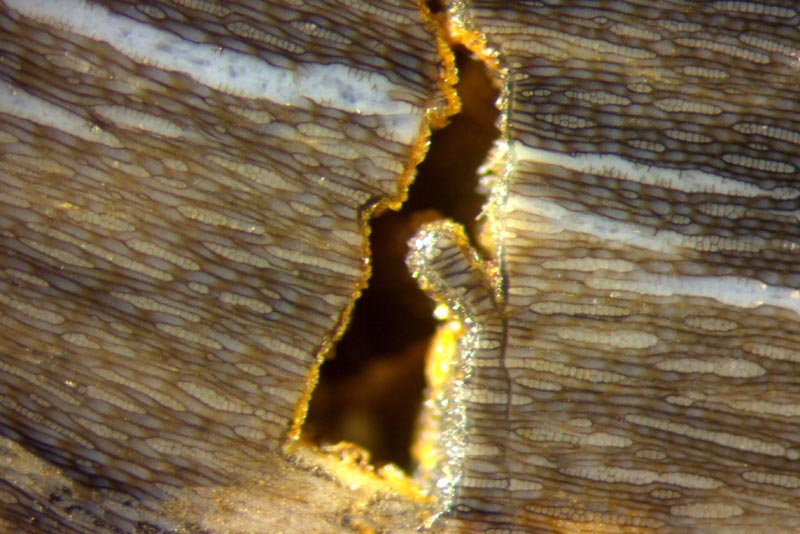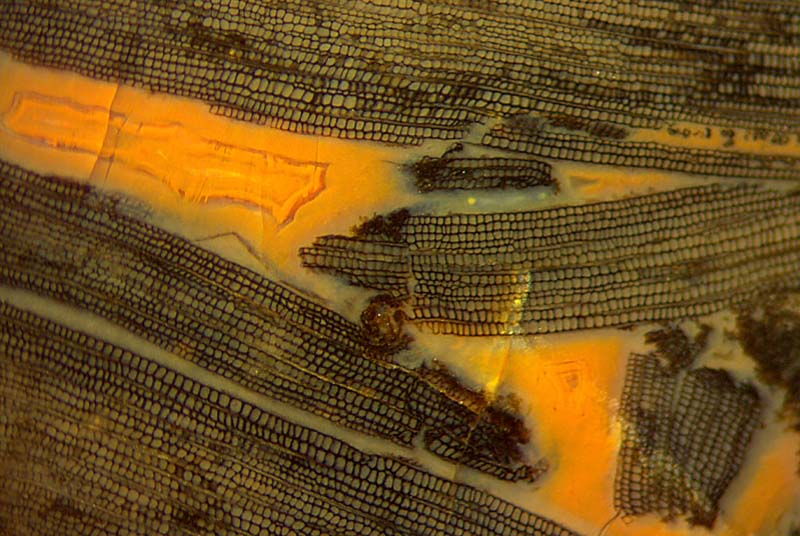Black
fossil wood aspect caused by fire or water ?
 The
present discussions on climate changes often
refer to charcoal from wildfires
[1] as evidence of occasional
dry seasons while land plants flourished. This has misled some less
careful palaeobotanists to see charcoal where there is only
black
wood.
The
present discussions on climate changes often
refer to charcoal from wildfires
[1] as evidence of occasional
dry seasons while land plants flourished. This has misled some less
careful palaeobotanists to see charcoal where there is only
black
wood.
To
differentiate between fossil charcoal and fossil black wood may require
careful investigation with advanced equipment [1,2] but there are
fossils, like the ones shown here, where charcoal can be excluded by
visual
inspection and simple
reasoning.
Soon
after the recovery of these chert samples at
Wilmsdorf in the Döhlen Basin, the mainly
black coniferous-type wood fragments well preserved therein were
mistaken by
professionals
for
fossil
charcoal, as dicussed in
Fossil
Wood News 9
.
Apparently they did not notice small details contradicting
the charcoal interpretation: patches of tissue with brown cell walls
instead of
black ones,
and large plastic deformations in some places (Figs.1, 2).
Subsequent contributions (Fossil
Wood News 9,
35, 37, 38.) have
helped to raise
the awareness
concerning erroneus charcoal claims.
Fig.1:
Cavity resultung from fracture and slip of the nearly but not quite
solid silicified wood, one column thereof leaning to the left before
final solidification. Image width 2.8mm.
Fig.2:
Coniferous-type wood torn into pieces while softened after lying in
water; with rolled-up cell files between two touching pieces. Image
width 3.5mm.

The
wood had lain in bog water for some time,
where it had lost its mechanical strength, possibly under the
influence of microbes, and had got a black stain. It easily
disintegrated into pieces of various sizes and shapes floating in the
bog water, suggesting an interpretation as
crushed charcoal
(Fig.2). After continuing supply of silicic acid from leached volcanic
ash
(?), everything turned into silica gel and finally into chalcedony.
The
tiny details indicating inelastic deformations in Figs.1,2 could not
have formed in brittle charcoal. They must have formed
while the wood was still flexible. A subsequent wildfire would
have destroyed
the
delicate structures.
Hence, there was no such, and this is no charcoal.
This contribution
is to show that by looking at details one may see whether black
fossil wood has got its aspect by fire or water.
Samples W/55, W/33 found in 1992 during the preparation of the golf
course
at Wilmsdorf, Doehlen Basin near Dresden, stored in the own collection.
H.-J.
Weiss 2021
[1] A.Jasper, D.
Uhl
et al.: Evidence of wildfires in the Late Permian …,
Current Science
110 No3 Feb.2016, 419-423.
[2] D.
Uhl, A.Jasper: Und
es brannte doch! Fossile
Holzkohle als Nachweis von Bränden in Perm und Trias - ein
Gelehrtenstreit?
www.researchgate.net/publication/233853938 (Jan.
2011)
 |

|
40 |


 The
present discussions on climate changes often
refer to charcoal from wildfires
[1] as evidence of occasional
dry seasons while land plants flourished. This has misled some less
careful palaeobotanists to see charcoal where there is only
black
wood.
The
present discussions on climate changes often
refer to charcoal from wildfires
[1] as evidence of occasional
dry seasons while land plants flourished. This has misled some less
careful palaeobotanists to see charcoal where there is only
black
wood.

